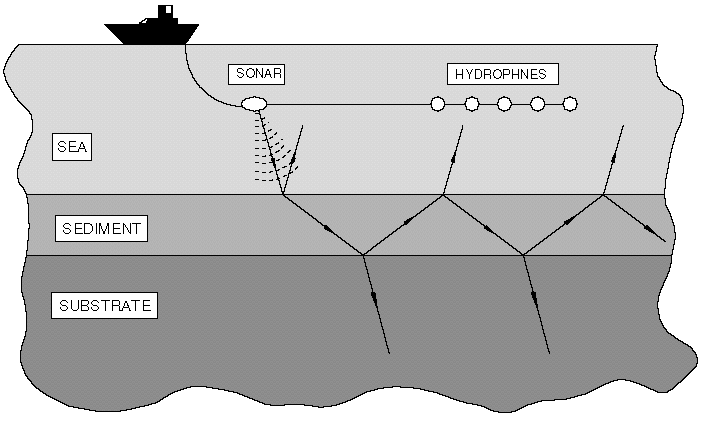
The Experimental Environment and Trace Path of a Single Ray

by Panagiotis Papadakis and Bradley Carr
In scientific areas such as geology, oceanography, seismology and in the identification of buried objects (i.e. cables, barrels, rocks, etc), knowledge of the geoacoustic parameters of the sea-bottom are crucial for their applications. In the Underwater Acoustics Division at the Institute of Applied and Computational Mathematics at FORTH, we are currently working on a research project in this area, namely to recover such properties as the density, sound speed and attenuation of bottom materials using a mathematical algorithm developed by the authors.
Drilling or seismic methods (such as explosions) are those mostly used today to determine which substances lie beneath the sea-bed. Both require placing instruments on the sea bottom, and involve long, replicated procedures. The method described below is fast, efficient ,and is already replacing existing costly methods.
The method adopted requires the use of an underwater sonar (a pulse source) and hydrophones (receivers) to transmit and receive wide-band signals to be used in our inversion scheme. The sonar and the receiving array is towed by a surface ship. The environment we assume is described pictorally in the figure.

The line extruding from the sonar describes the path of a single ray from the longitudinal wave, and the relative reflections and refractions that are undergone en route. The characteristics of the bottom layers determine the profile and magnitude of the returned sound wave received by the hydrophones after some time. The profile of the returned signal varies with the bottom parameters, and is unique. With prior knowledge of the mean density and sound speed in the sea, and by comparing the reflected signal with the incidence signal for two different angles, we calculate the reflection coefficients (ratio of the intensities of sound between the reflected and incident signals) through the frequency range, to be used as input data for our inverse scheme. The output of the inverse procedure are
The program currently being developed requires no mathematical knowledge on the part of the user operating the system. All the optimisation parameters used in the inverse scheme are estimated using mathematical algorithms. Without these extra calculations, the user would have to perform many tasks which in itself requires some advanced mathematical theory. We are coupling minimised input with maximised output for speed and accuracy.
For those seeking a more explicit description of the inverse method mathematically, we direct readers to the Proceedings of the "22nd International Symposium on Acoustic Imaging" conference to be held in Florence, Italy, which will be published later this year.
This project is partially funded by the European Commission within the framework of the COMETT and MAST II programmes.